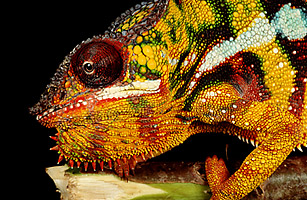
Panther chameleon.
(2 of 3)
Through our growing numbers, our thirst for natural resources and, most of all, climate change — which, by one reckoning, could help carry off 20% to 30% of all species before the end of the century — we're shaping an Earth that will be biologically impoverished. A 2008 assessment by the International Union for Conservation of Nature found that nearly 1 in 4 mammals worldwide was at risk for extinction, including endangered species like the famous Tasmanian devil. Overfishing and acidification of the oceans are threatening marine species as diverse as the bluefin tuna and reef-forming corals. "Just about everything is going down," says Simon Stuart, head of the IUCN's species-survival commission. "And when I think about the impact of climate change, it really scares me."
Scary for conservationists, yes, but the question arises, Why should it matter to the rest of us? After all, nearly all the species that were ever alive in the past are gone today. Evolution demands extinction. When we're using the term extinction to talk about the fate of the U.S. auto industry, does it really matter if we lose species like the Holdridge's toad, the Yangtze River dolphin and the golden toad, all of which have effectively disappeared in recent years? What does the loss of a few species among millions matter?
For one thing, we're animals too, dependent on this planet like every other form of life. The more species living in an ecosystem, the healthier and more productive it is, which matters for us — a recent study by the World Wildlife Fund (WWF) estimates the economic value of the Amazon rain forest's ecosystem services to be up to $100 per hectare (about 2½ acres). When we pollute and deforest and make a mess of the ecological web, we're taking out mortgages on the Earth that we can't pay back — and those loans will come due. Then there are the undiscovered organisms and animals that could serve as the basis of needed medicines — as the original ingredients of aspirin were derived from the herb meadowsweet — unless we unwittingly destroy them first. "We have plenty of stories about how the loss of biodiversity creates problems for people," says Carter Roberts, WWF's president.
Forests razed can grow back, polluted air and water can be cleaned — but extinction is forever. And we're not talking about losing just a few species. In fact, conservationists quietly acknowledge that we've entered an age of triage, when we might have to decide which species can truly be saved. The worst-case scenarios of habitat loss and climate change — and that's the pathway we seem to be on — show the planet losing hundreds of thousands to millions of species, many of which we haven't even discovered yet. The result could be a virtual genocide of much of the animal world and an irreversible impoverishment of our planet. Humans would survive, but we would have doomed ourselves to what naturalist E.O. Wilson calls the Eremozoic Era — the Age of Loneliness.
So if you care about tigers and tamarins, rhinos and orangutans, if you believe Earth is more than just a home for 6.7 billion human beings and counting, then you should be scared. But fear shouldn't leave us paralyzed. Environmental groups worldwide are responding with new methods to new threats to wildlife. In hot spots like Madagascar and Brazil, conservationists are working with locals on the ground, ensuring that the protection of endangered species is tied to the welfare of the people who live closest to them. A strategy known as avoided deforestation goes further, incentivizing environmental protection by putting a price on the carbon locked in rain forests and allowing countries to trade credits in an international market, provided that the carbon stays in the trees and is not cut or burned. And as global warming forces animals to migrate in order to escape changing climates, conservationists are looking to create protected corridors that would give the species room to roam. It's uncertain that any of this will stop the sixth extinction wave, let alone preserve the biodiversity we still enjoy, but we have no choice but to try. "We have a window of opportunity," says Kassie Siegel, director of the climate, energy and air program of the Center for Biological Diversity (CBD). "But it's slamming shut."
To Save the Species, Save the People
Madagascar, which Mittermeier calls the "hottest of the hot spots," is where all the new strategies can be road-tested. In 2003, after decades when conservation was barely on the government's agenda, then-President Marc Ravalomanana announced that the government would triple Madagascar's protected areas over the following five years. That decision helped underfunded parks like Andasibe's, which protects some of the last untouched forest on the island. "You can't save a species without saving the habitat where it lives," says WWF's Roberts.
Do that right, and you can even turn a profit in the process. In Madagascar, half the revenues from national parks are meant to go to the surrounding communities. The reserves in turn help sustain an industry for local guides like Razafindrasolo. In a country as poor as Madagascar — where 61% of the people live on less than $1 a day — it makes sense to give locals an economic stake in preserving wildlife rather than destroying it. "If you don't get the support of the people living near a conservation area, it's just a matter of time before you'll lose [the area]," says Steven Sanderson, president of the Wildlife Conservation Society (WCS).